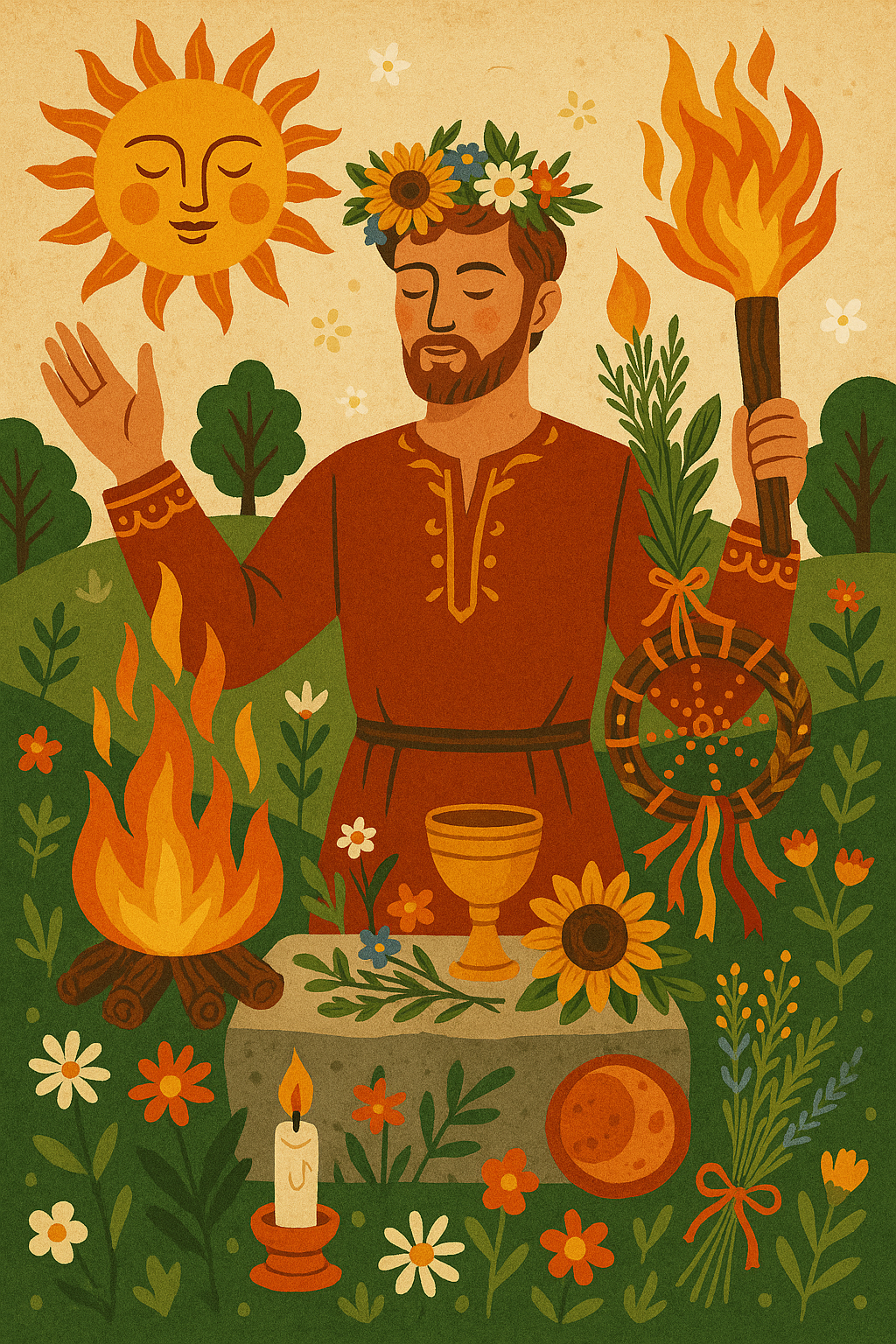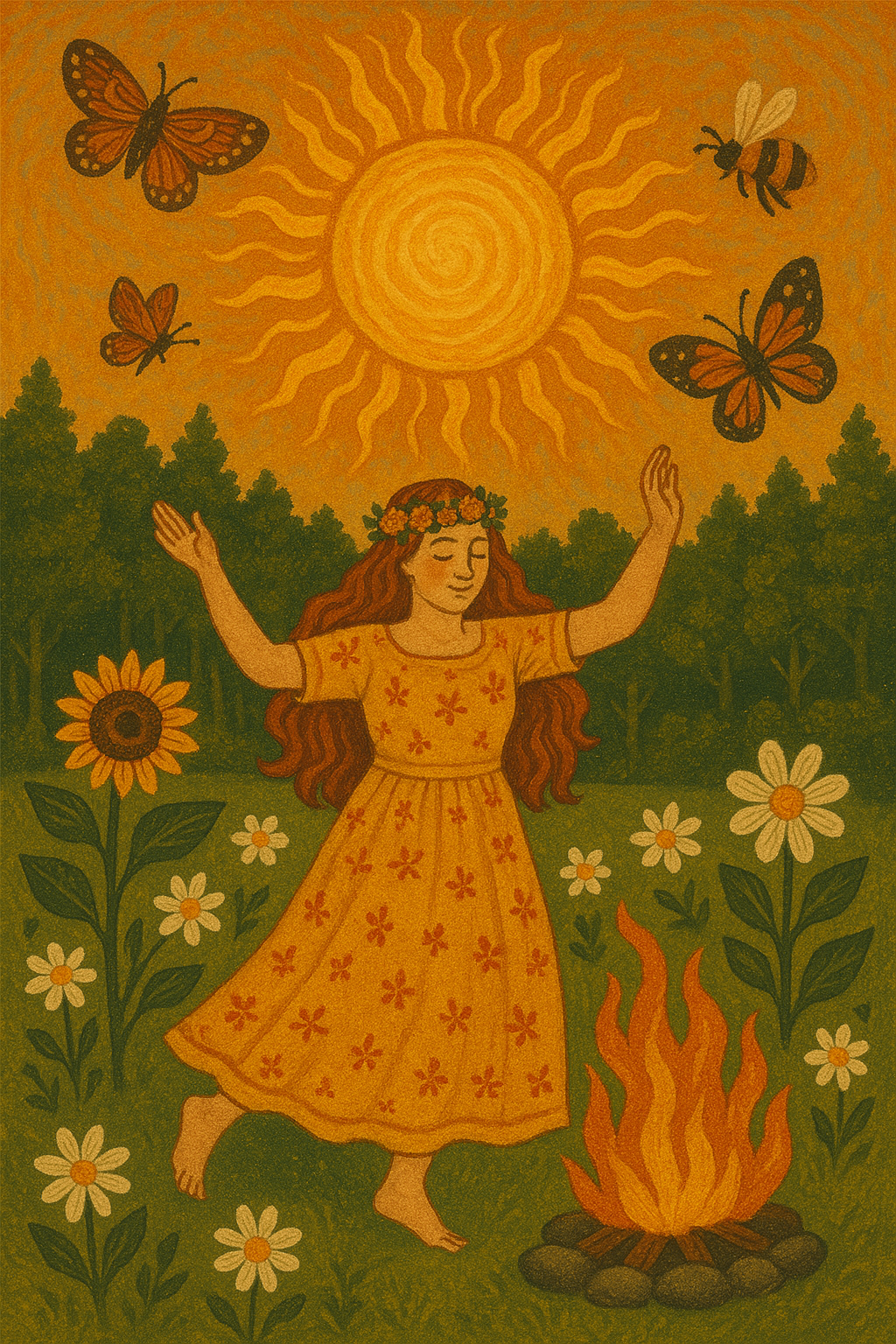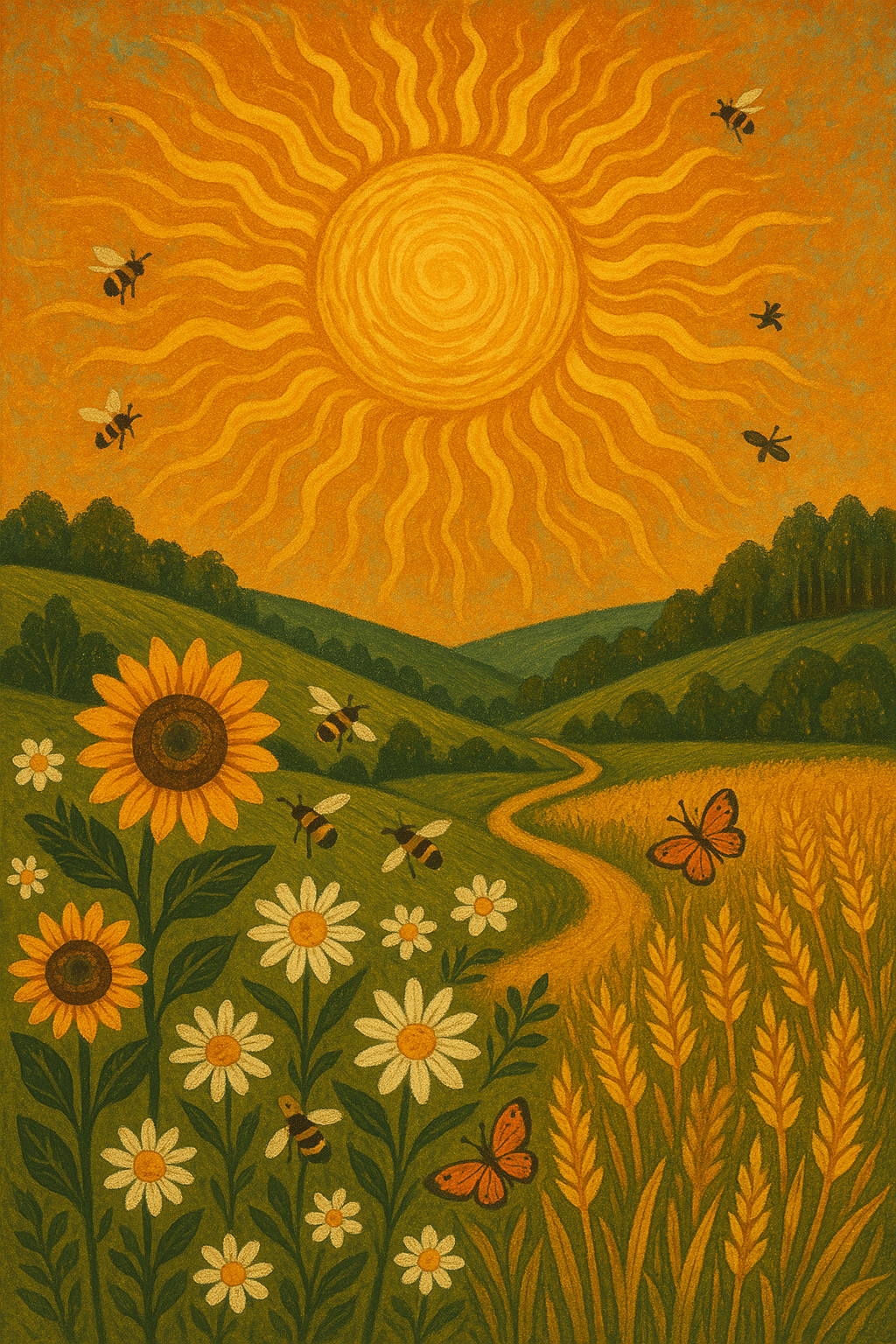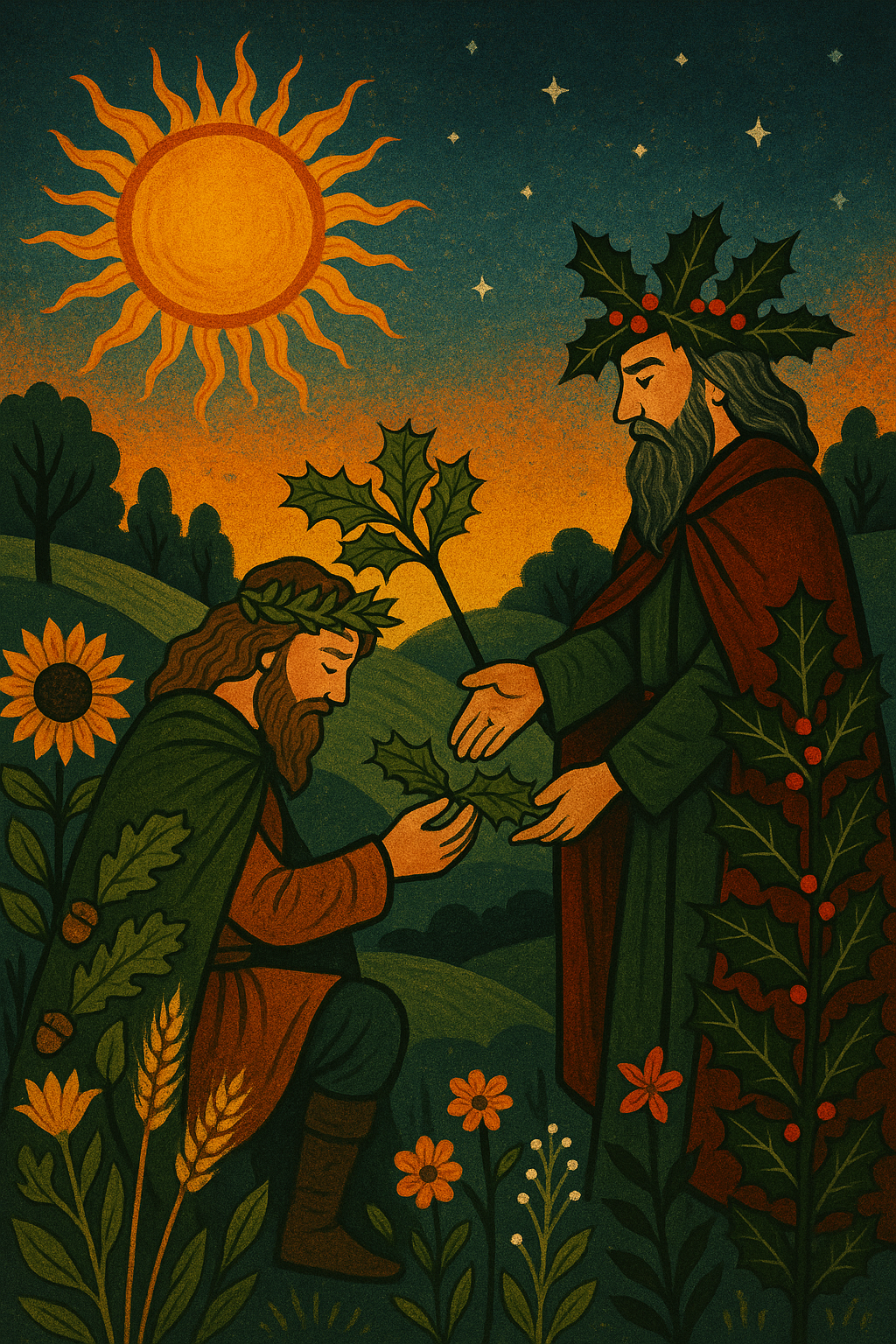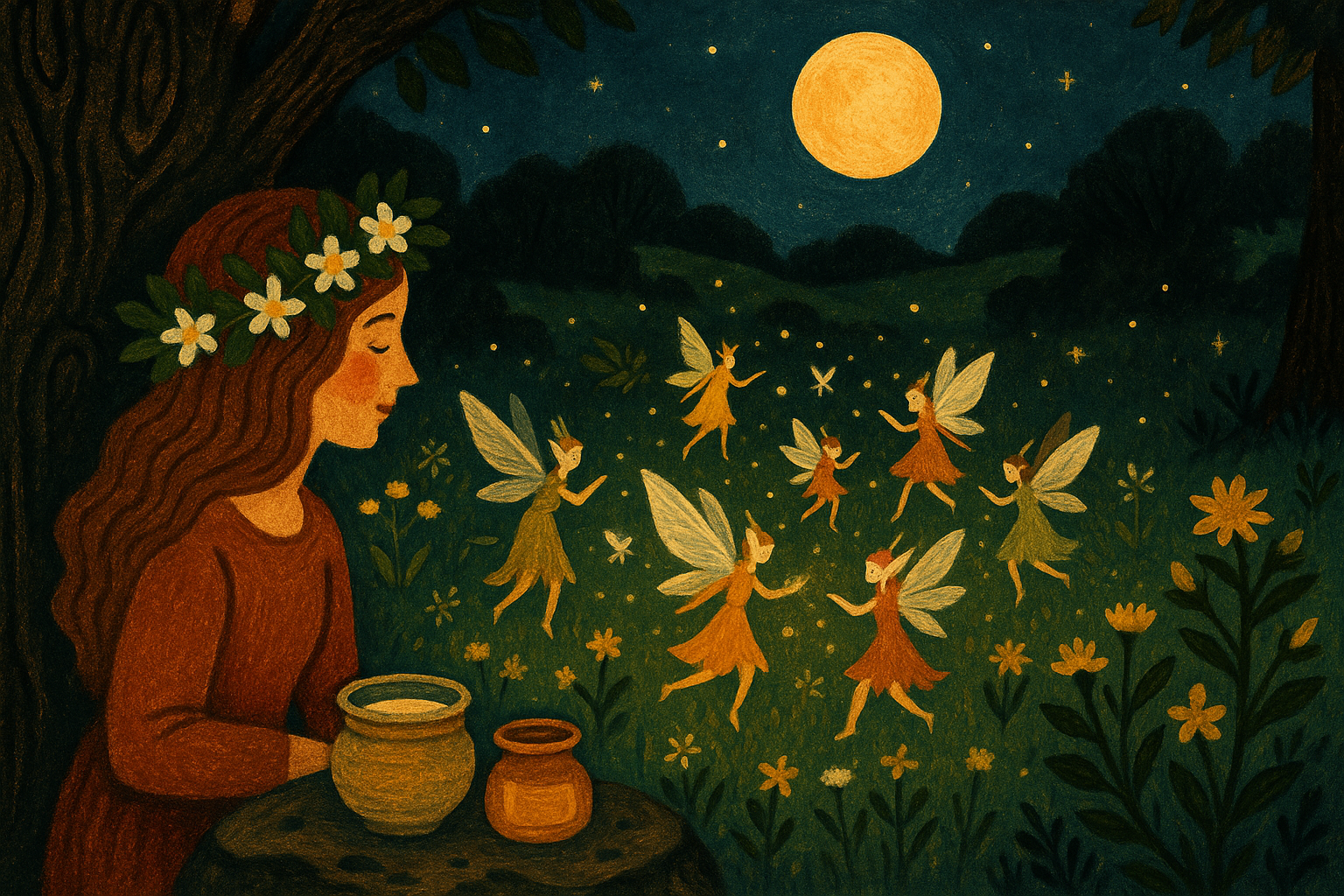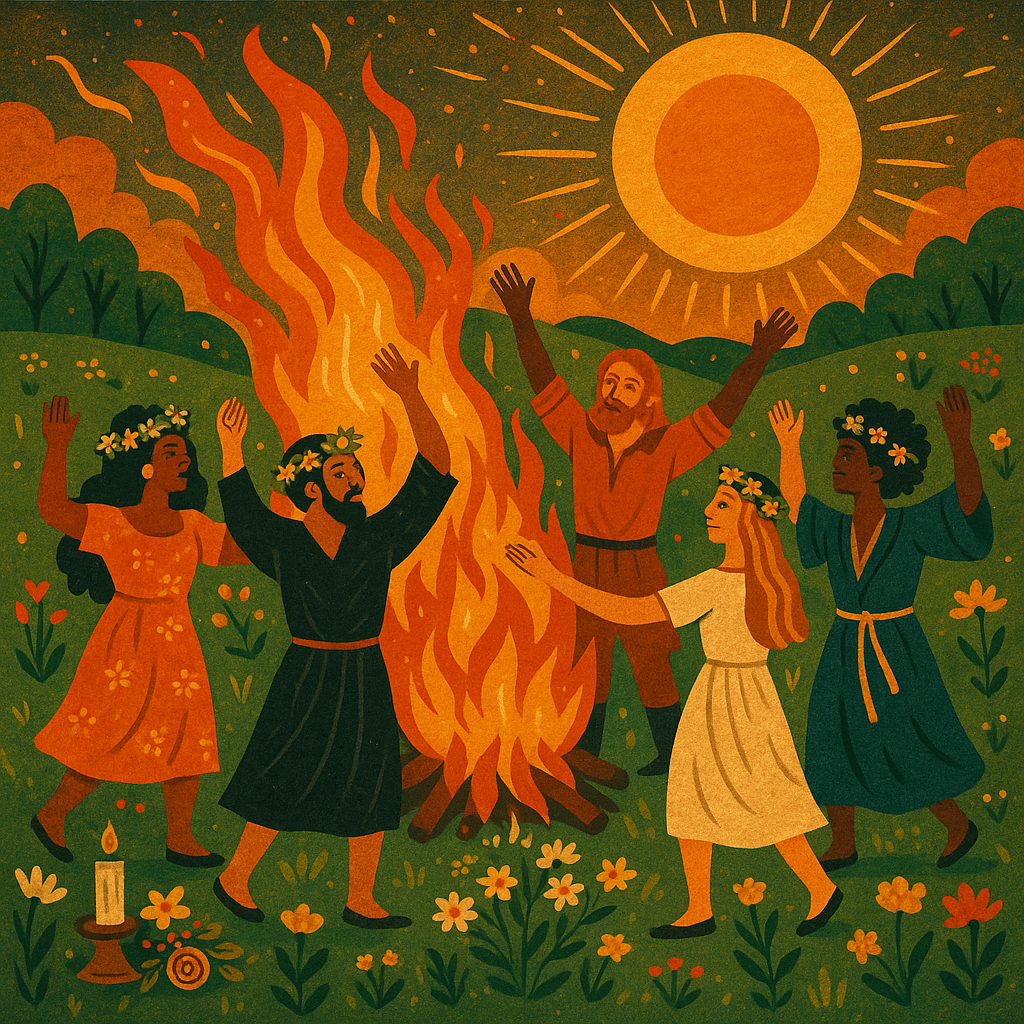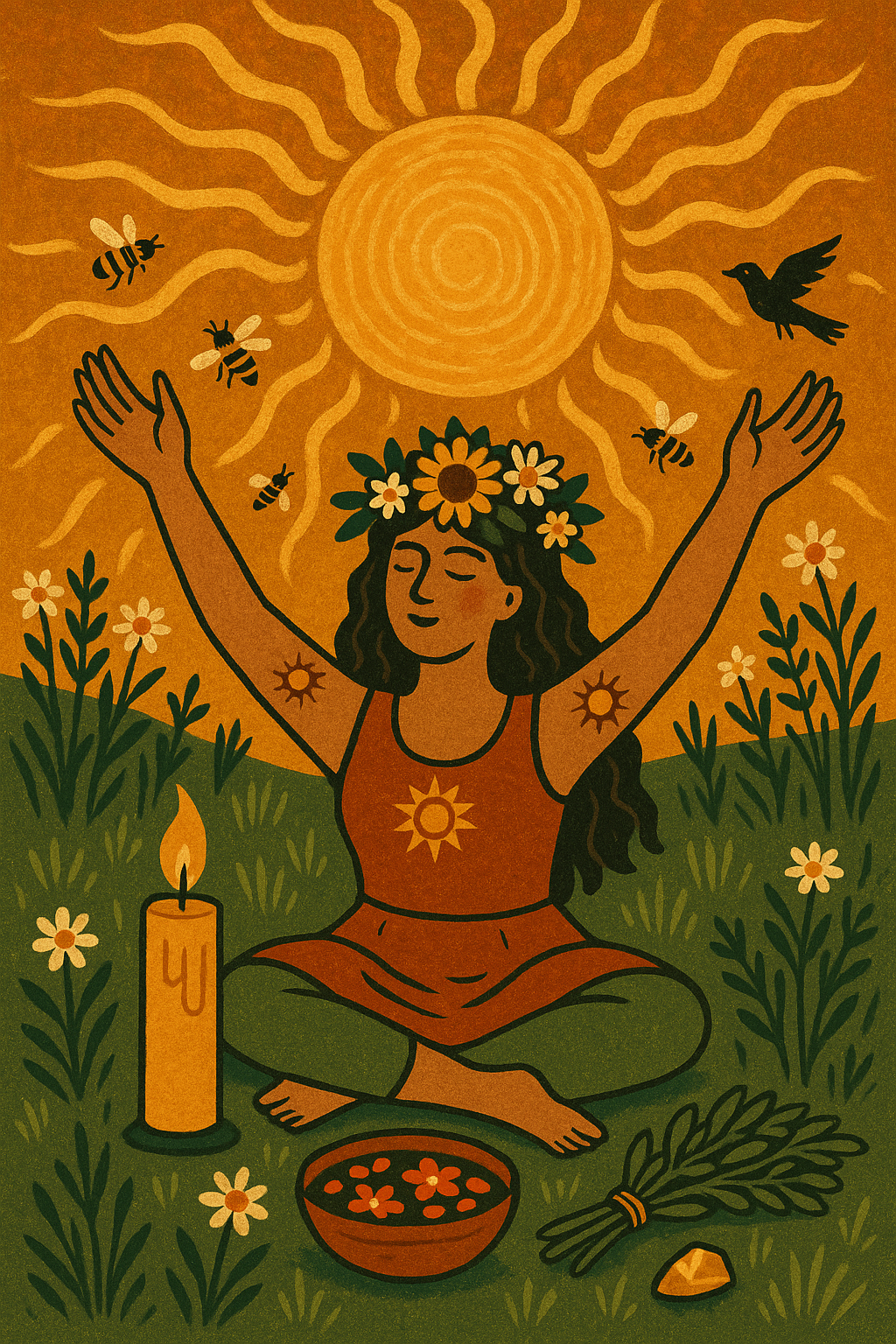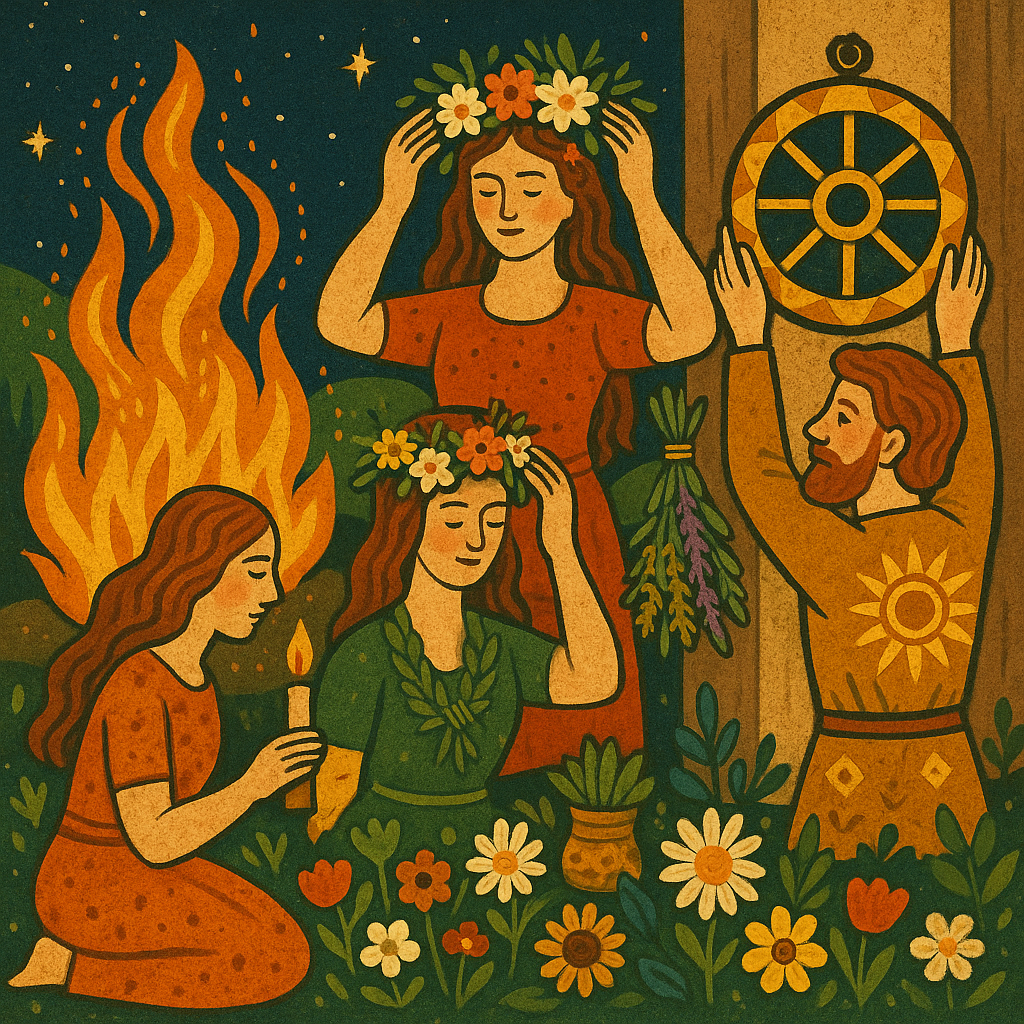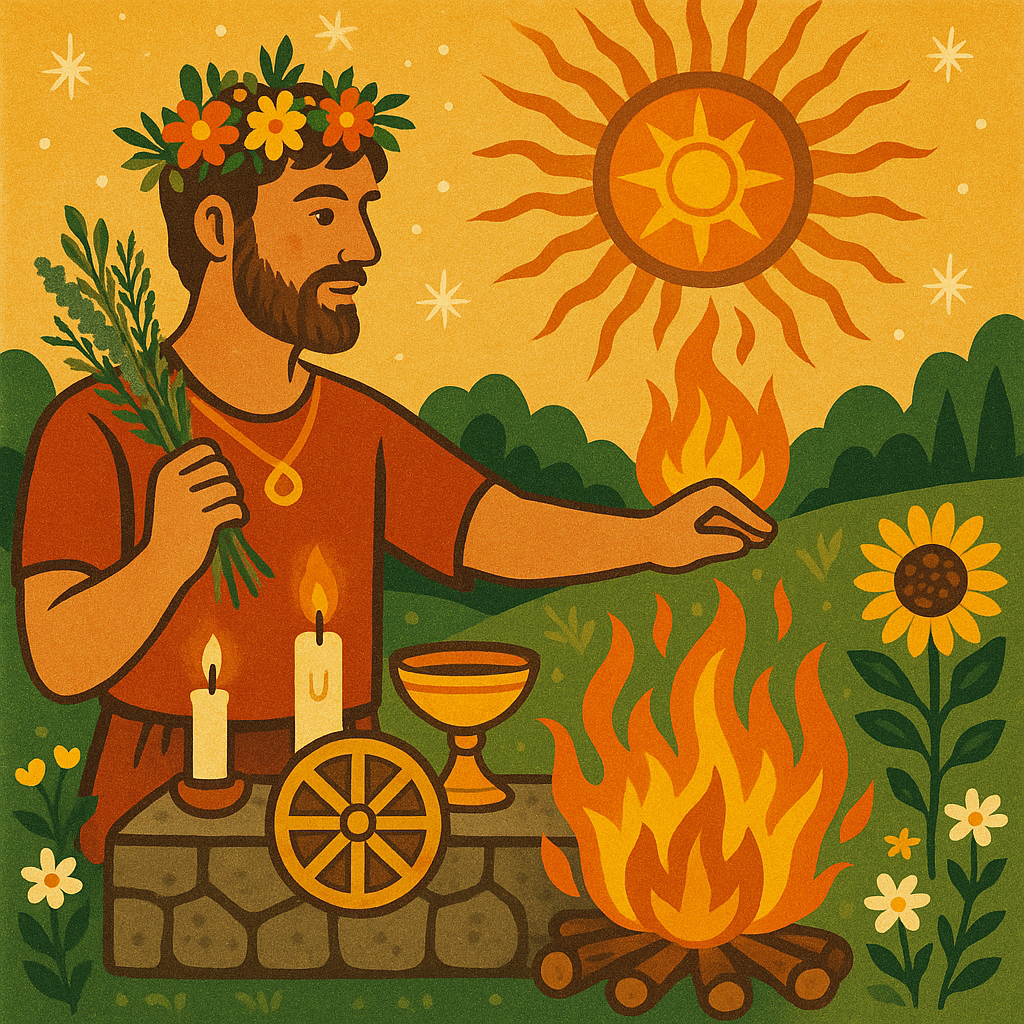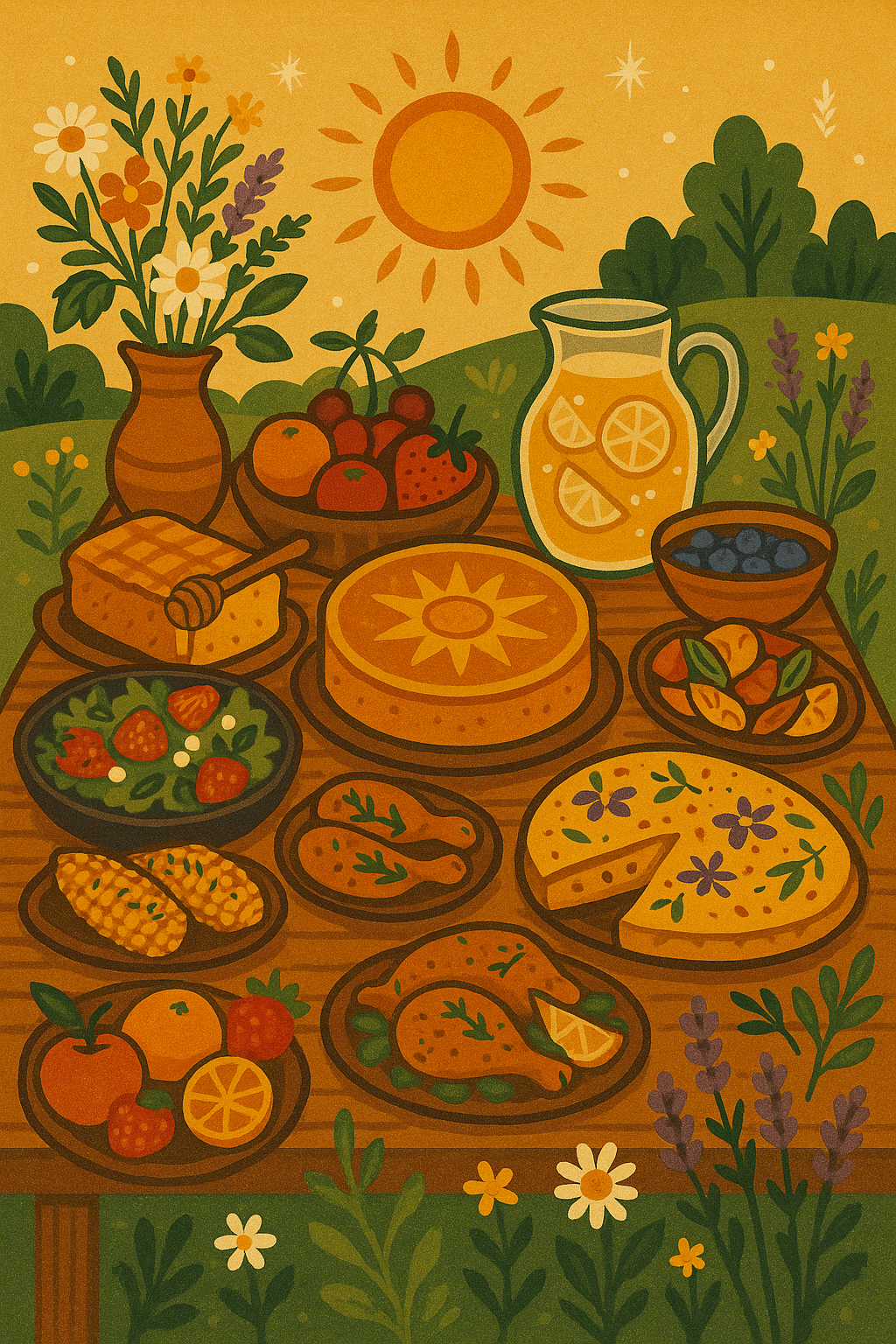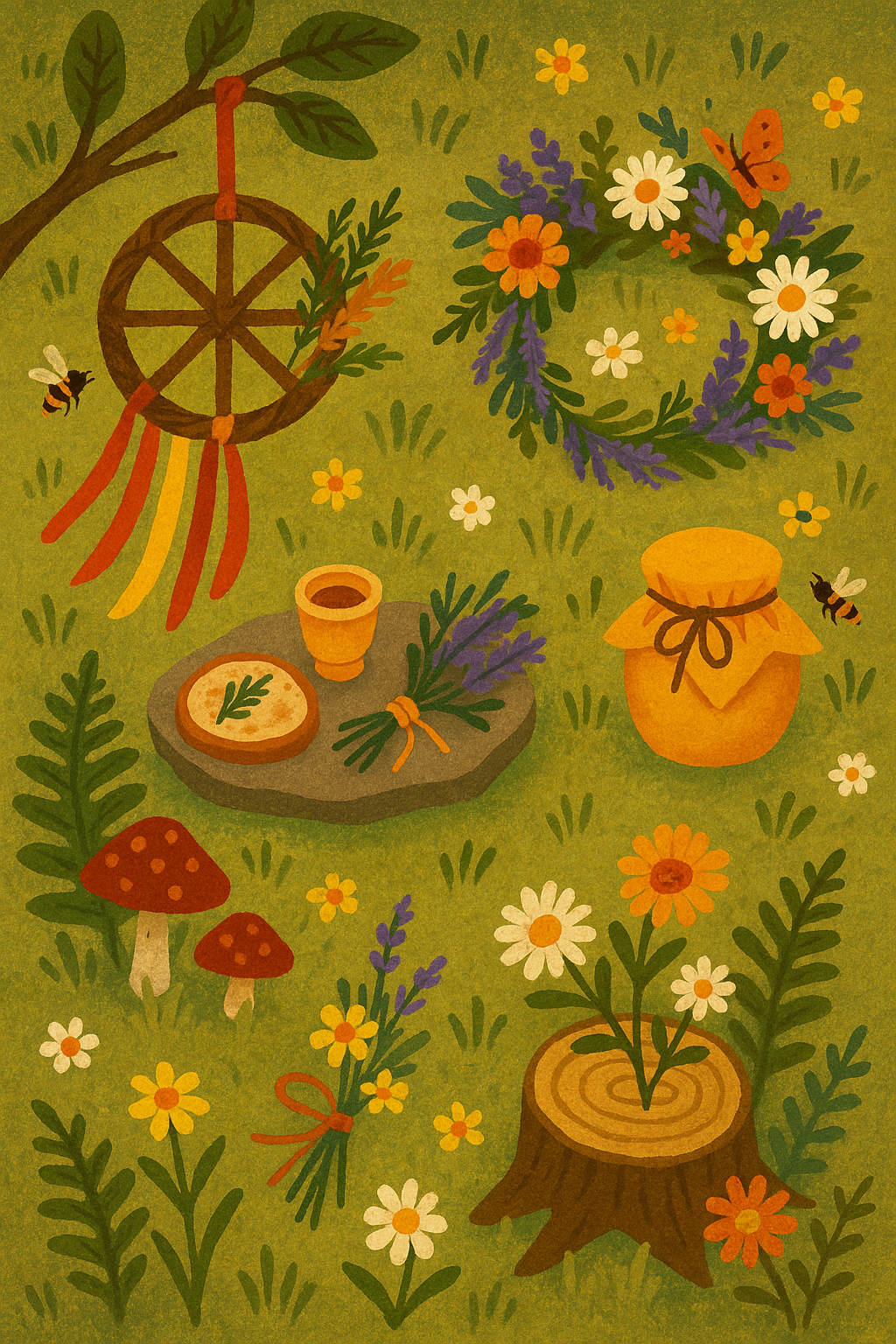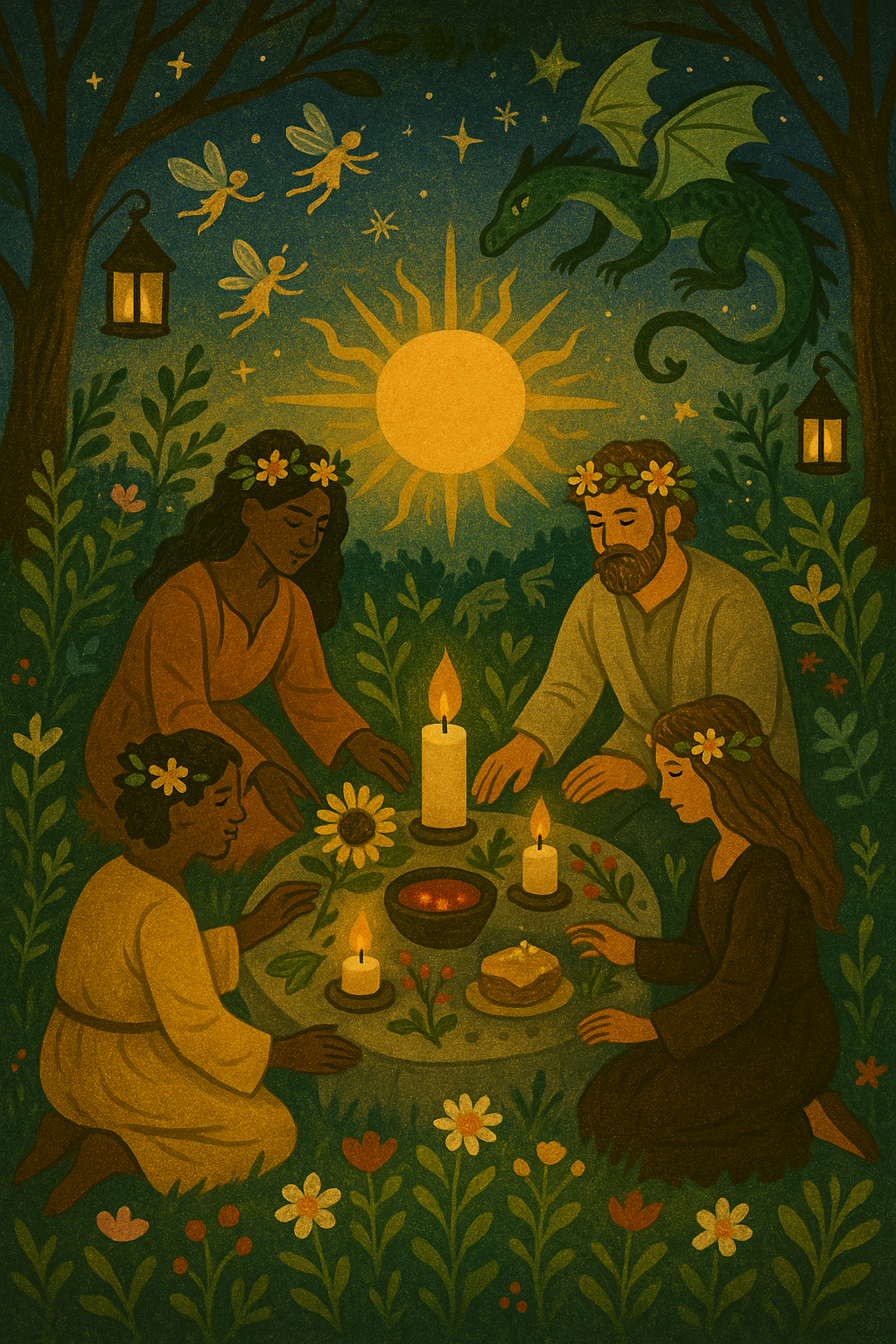Discover the meaning of Litha, the Wiccan sabbat that honors the summer solstice. Explore rituals, magical crafts, traditional foods, and ways to celebrate the longest day of the year with intention and sunlit joy.
The first rays of morning stretch across the sky like golden fingers, warming the dewy grass and painting the treetops in fire. Birds are already busy in the hedgerows, bees hum like a chant in the fields, and somewhere in the distance, a barefoot figure turns their face to the sky.
It’s the longest day of the year — the sun’s triumphant moment. Everything is blooming, buzzing, bursting with life. The air feels thick with enchantment. If you listen closely, you might even hear laughter just beyond the veil — the kind that flickers at the edge of dreams. Midsummer is here, and with it, Litha — the sun’s high holiday, a time to celebrate light, strength, and the sweet fullness of the season.
Whether you rise with the dawn or dance beneath the stars, this is a moment to honor your power, your path, and the magic of being alive in the height of summer.
The Origins and Meaning of Litha
Litha (pronounced Lee-tha or sometimes Lit-ah, depending on tradition) marks the summer solstice — the longest day and shortest night of the year. It falls around June 20 and 21 in the Northern Hemisphere, when the sun reaches its highest point in the sky.
For Wiccans and many modern pagans, Litha is the solar climax of the Wheel of the Year — a fiery, golden celebration of growth, joy, abundance and light. It’s a time to revel in nature’s bounty, to celebrate all that has blossomed since spring, and to honor the turning point as the days now begin, slowly, to shorten.
It follows Beltane, the fiery celebration of fertility and union, and comes before Lughnasadh (or Lammas), the first harvest festival. While Imbolc and Ostara sparked the light, and Beltane ignited passion, Litha is the sun in full blaze — a moment to honor life at its fullest, just before the wheel turns toward the waning half of the year. Like Mabon and Yule, its power lies in transition — and in the magic of balance shifting.
As such, Litha invites reflection as well as revelry — a pause in the sunlight to take stock of what you’ve grown, and where you’re headed.
Historically, midsummer festivals were marked with bonfires, dancing, and rituals to protect crops, cattle and communities. In Norse tradition, blazing wheels were rolled down hills to mimic the sun’s path. In ancient Rome, festivals for Juno and Vesta aligned with the solstice, while in Slavic countries, it was a time of fertility rites and water magic.
Every culture that watched the sun’s rise knew this moment mattered. And it still does.
Myths and Folklore of Midsummer Magic
Long before clocks and calendars, our ancestors watched the skies. They knew when the sun lingered a little longer, when shadows shrank and golden light stretched into the evening. And on that brightest day, they told stories — of gods who set the sky ablaze, of faeries who danced through ferns, of fires lit to keep chaos at bay.
One of the most enduring myths of the solstice is that epic battle between the Oak King and the Holly King — twin aspects of the Horned God. At Yule, the Oak King is born, gaining strength as the days lengthen. At Litha, he reaches his peak — and then falls in ritual battle to the Holly King, who rules the waning year. It’s a beautiful allegory of the natural cycle: Even at the height of power, change is inevitable. Even in light, shadow waits.
Elsewhere, the solstice shines with the brilliance of deities:
Lugh, the Celtic god of the sun and many skills, whose name means “Light.” Though more often honored at Lughnasadh, his energy pulses through Litha’s creative fire.
Amaterasu, the Japanese sun goddess, who once hid herself away in a cave, plunging the world into darkness — until the laughter of the gods lured her out, restoring light.
Ra, the Egyptian sun god, who sails across the sky each day in his solar barque, battling the chaos serpent Apep each night to rise again.
Apollo, golden-haired and lyre-strumming, who, in some tellings, carries the sun in his chariot, and lights the world with prophecy, music and flame.
And then there are the tales of midsummer Fae — the Good Folk who slip more easily between worlds on nights like these. In Celtic and Germanic folklore, Midsummer’s Eve was a time of enchantment, when doors opened between realms. People wove flower crowns to protect themselves, gathered St. John’s wort to banish spirits, and placed iron charms at thresholds to keep mischief out. But some sought the fairies, laying out milk and honey and dancing under the moon in hopes of catching a glimpse of their revels.
Even Shakespeare knew the magic of this night. A Midsummer Night’s Dream — with its mix of love, trickery and wild enchantment — captures the sense that on this night, anything might happen.
So if the air feels thick with possibility… if a shadow in the trees lingers longer than it should… you’re not imagining it. Midsummer is a time of stories — and you’re living in one.
Traditions of Litha
Litha traditions shimmer with light: fire, flowers, golden feasts, and the joy of long, lingering days. At the heart of it all is a sense of celebration: The Earth is alive, generous and radiant. And you’re invited to join the dance.
Across centuries and cultures, solstice traditions share one common thread: light triumphing over darkness, even if only for a moment. People built bonfires to mimic the sun, leapt through flames for luck and fertility, and crafted garlands and charms to honor nature in full bloom.
Here are some of the most common — and magical — ways to honor Litha:
Sunrise and Sunset Vigils
Start your celebration with intention: Rise with the sun, and greet it as it crests the horizon. Some Wiccans stay up through the night to watch it rise; others pause at noon to feel the day’s full power. As the sun sets, light candles or a small fire to carry the energy into the evening.
Bonfires and Solar Flames
Traditionally, solstice fires were lit on hilltops to honor the sun and strengthen crops. Today, lighting a candle, firepit or even a flame in your heart can serve the same purpose — a symbol of your inner fire and the light you carry forward.
Floral Crowns and Herb Bundles
Wear the season on your head — quite literally — by weaving flower crowns from midsummer blooms: sunflowers, daisies, chamomile, roses. Bundle herbs like St. John’s wort, rosemary and lavender for protection and clarity. Hang them by your door or burn them as offerings.
Rolling Sun Wheels
In some traditions, wooden wheels were set ablaze and rolled down hills to represent the sun’s journey. You don’t need to torch your garden cart, but making a sun wheel from grapevine or craft supplies and hanging it on your door brings the symbolism home.
Symbols and Correspondences of Litha
Colors:
Gold, yellow, orange for the sun and fire
Green for growth and abundance
Red for passion and vitality
Crystals:
Sunstone boosts confidence and leadership
Citrine for joy, abundance, and energy
Carnelian fires up creativity and motivation
Amber links to ancient sunlight and protective energy
Herbs and Plants:
St. John’s wort to ward off negativity
Chamomile brings peace and clarity
Rosemary for memory, cleansing
Lavender provides calm and spiritual connection
Oak leaves and acorns, sacred to the Oak King
Animals:
Bees represent industrious joy and sweet results
Stags for strength and the wild, sacred masculine spirit
Songbirds symbolize communication and delight
Dragons for the fire of transformation and protection
When you’re surrounded by sunflowers and the air hums with bees, it’s easy to understand why our ancestors paused to celebrate. Litha reminds us to honor our own light, too — to revel in what we’ve grown, and to shine brightly while we can.
A Litha Ritual to Ignite Your Inner Fire
Whether you’re practicing alone or with your coven, Litha calls for something joyful, golden and alive. This isn’t the time for subtlety — it’s the sun’s main act. So light a flame, crown your head in flowers, and step into your strength. Midsummer has long been considered one of the most powerful times of the year for magic.
Below is a ritual designed to help you align with midsummer’s powerful energy. It culminates in a spell crafted to awaken your personal power and confidence — to help you shine as brightly as the solstice sun.
Before You Begin
Choose a time near sunrise, noon or sunset. A backyard, balcony or sunny window is ideal. Dress in sun-kissed colors (yellows, reds, golds and greens). Optional: Wear a floral crown, sun charm, or something that makes you feel radiant.
What You’ll Need
A yellow or gold candle (or a fire-safe bonfire or cauldron)
A fresh bay leaf (or oak leaf), and a gold or red pen
A bowl of water (preferably rainwater or spring water)
A small mirror
Any altar decorations you like — sunflowers, herbs, crystals, seasonal fruit or a solar deity image
Step 1: Prepare your altar and cast the circle.
Arrange your altar in the center of your space. Add symbols of the season: a sunflower in a jar, a handful of cherries, a sprig of rosemary. Light your candle and say:
Brightest day and golden flame,
I call the sun by sacred name.
With fire and fruit, with song and cheer,
Litha’s light, be with me here.
Cast your magic circle as you normally do, walking clockwise and calling on the elements. Emphasize fire and air, the season’s dominant energies.
Step 2: Call on the sun and the self.
Face the sun (or your candle flame) and speak:
Great Sun, high above, I honor your strength.
You blaze at your peak, and so do I.
Shine through me — may your light awaken what I already carry.
Take a deep breath and feel that light fill your chest.
Step 3: Cast a spell of solar strength.
Take your bay leaf. With your gold pen, write one word that represents the strength you wish to step into now:
Confidence. Boldness. Courage. Radiance. Truth.
Hold the leaf in both hands. Focus on it — not just the word, but what it would feel like to live it. Speak this chant:
Sun above and fire below,
Grant me strength to rise and glow.
Let fear fall off, let doubt grow dim,
My inner light outshines the grim.
If you’re using a mirror, hold the leaf to your heart and look yourself in the eye. Say:
This is the truth I now reveal—
I am whole, and I am real.
Then, drop the leaf into the bowl of water. Imagine that as the leaf moves, your power rises. The strength you called is already yours.
Finish with:
With sun’s embrace and sky’s wide dome,
My power stirs and finds its home.
Step 4: Close the circle and celebrate.
Thank the elements and release your circle. Let the candle burn out safely or snuff it with intention.
Dispose of the leaf respectfully — bury it beneath a blooming plant, compost it, or pour the water into the soil. If you used a mirror, keep it on your altar for a few days as a reminder of the light you claimed.
Then eat something delicious. Dance barefoot. Watch the sunset. You just honored the height of the sun — and the fire inside you.
Feasting With the Sun: Foods of Litha
What better way to celebrate the fullness of life than with a feast bursting with summer’s brightest flavors? Litha is a festival of abundance — a time to honor the Earth’s generosity and the energy that ripens every fruit, herb and grain. Whether you’re throwing a solstice picnic or preparing a quiet sunlit brunch, let your table reflect the richness of the season.
Seasonal Staples
Litha food is sun food: golden, juicy, herbaceous and joyful.
Fruits:
Cherries, strawberries, blueberries, peaches — served fresh or baked into hand pies
Lemons and oranges for lemonade, tartlets or citrus-glazed cakes
Herbs:
Rosemary, basil, mint, lavender, thyme tossed into salads, folded into doughs, infused in syrups
St. John’s wort (not to ingest, but nice as a tea blend or altar offering)
Savory ideas:
Herbed flatbreads or focaccia with edible flowers
Grilled corn brushed with butter and smoked paprika
Honey-glazed chicken or lemon-rosemary roasted vegetables
Fresh greens with berries, goat cheese and sunflower seeds
Sweet treats:
Honey drizzled over everything, from toast to berries to cornbread
Sun cakes (round golden cakes flavored with honey or citrus)
Lavender shortbread cookies
Honey mead, lemonade or herbal sun tea brewed in a jar outside
Simple Recipe: Honey & Lavender Lemonade
You’ll need:
1 cup fresh lemon juice
3 to 4 tablespoons honey (to taste)
2 teaspoons dried lavender
4 cups water
Instructions:
1. In a small saucepan, heat 1 cup of water with the lavender and honey until the honey dissolves.
2. Let steep 10 to 15 minutes, then strain.
3. Mix the lavender-honey water with lemon juice and the remaining water. Chill and serve over ice with a sprig of mint or slice of lemon.
Bonus points if you brew this under the sun and stir it with intention.
Whether you eat alone, with loved ones, or leave an offering outside for the Fae, the act of feasting at Litha is a sacred one. That nourishment can be a spell in itself. That gratitude tastes best when shared.
Crafts and Offerings for the Solstice
At Litha, your hands can become an altar. Whether you’re weaving flowers, tying charms, or placing honey cakes in the garden, crafting is a form of spellwork — one that honors both the season and your own creative fire.
These are not just pretty pastimes. They’re echoes of ancient practices — ways to connect with the Earth, the sun and the unseen.
Make a sun wheel.
This classic midsummer craft channels the ancient tradition of burning sun wheels rolled down hills. You can make a simple one from grapevine, willow branches or even embroidery hoops.
Decorate it with ribbons in gold, orange and red. Add sprigs of rosemary, wheat stalks or little sun charms. Hang it on your front door or above your altar as a symbol of light and strength.
Weave a flower crown.
A floral crown is more than just a boho accessory — it’s a living halo. In old midsummer traditions, people wore garlands to protect against Fae mischief or attract blessings.
Use whatever blooms are local and seasonal — daisies, clover, lavender, marigolds, even wild herbs. As you weave each stem, speak a word of intention or blessing: joy, courage, abundance, love. Then wear your creation during your ritual or feast.
Create a fairy offering.
Midsummer’s Eve is said to be one of the Fae’s favorite nights. If you’d like to stay on their good side (or invite a bit of their magic), prepare a small offering.
Ideas include:
A thimble of honey or mead
A slice of bread with butter and herbs
Wildflowers tied with twine
A shiny stone or tiny bell
Leave your offering at the base of a tree, beneath a fern, or on your windowsill. Whisper a wish as you walk away — and don’t look back.
Craft a solar sachet.
Gather herbs associated with the sun — such as rosemary, chamomile, calendula and St. John’s wort — and tie them up in a yellow or gold cloth.
Hold it in your hands and say:
Sun in sky and fire in me,
Let this charm bring strength to be.
Keep it near your bed, your altar, or in your bag when you need a boost of solar energy.
These crafts may seem small — but they’re woven with meaning, intention and magic. And that’s the heart of Litha: turning sunlight into something sacred.
What Litha Teaches Us
Litha is a celebration of light — not just the kind that bathes the Earth in gold, but the kind that flickers in your chest when you laugh too hard, take a bold leap, or finally speak your truth out loud.
At the solstice, the sun stands still. Just for a breath. A golden pause between the rising and the falling. That stillness is a gift — an invitation to ask: What have I grown? What am I proud of? What do I carry forward into the next season of my life?
Because, after Litha, the light begins to wane. The wheel turns. The days shorten, slowly at first. So this moment — this fire-bright, blossom-heavy, bee-laced moment — is fleeting. And that’s what makes it sacred.
So wear the crown. Light the fire. Chant your name to the sky. Share the honeyed bread. Leave a gift for the Fae. And let yourself feel it all — the joy, the courage, the wild magic humming in your bones.
Because you, too, are made of sunlight.
And you were always meant to shine. –Wally
